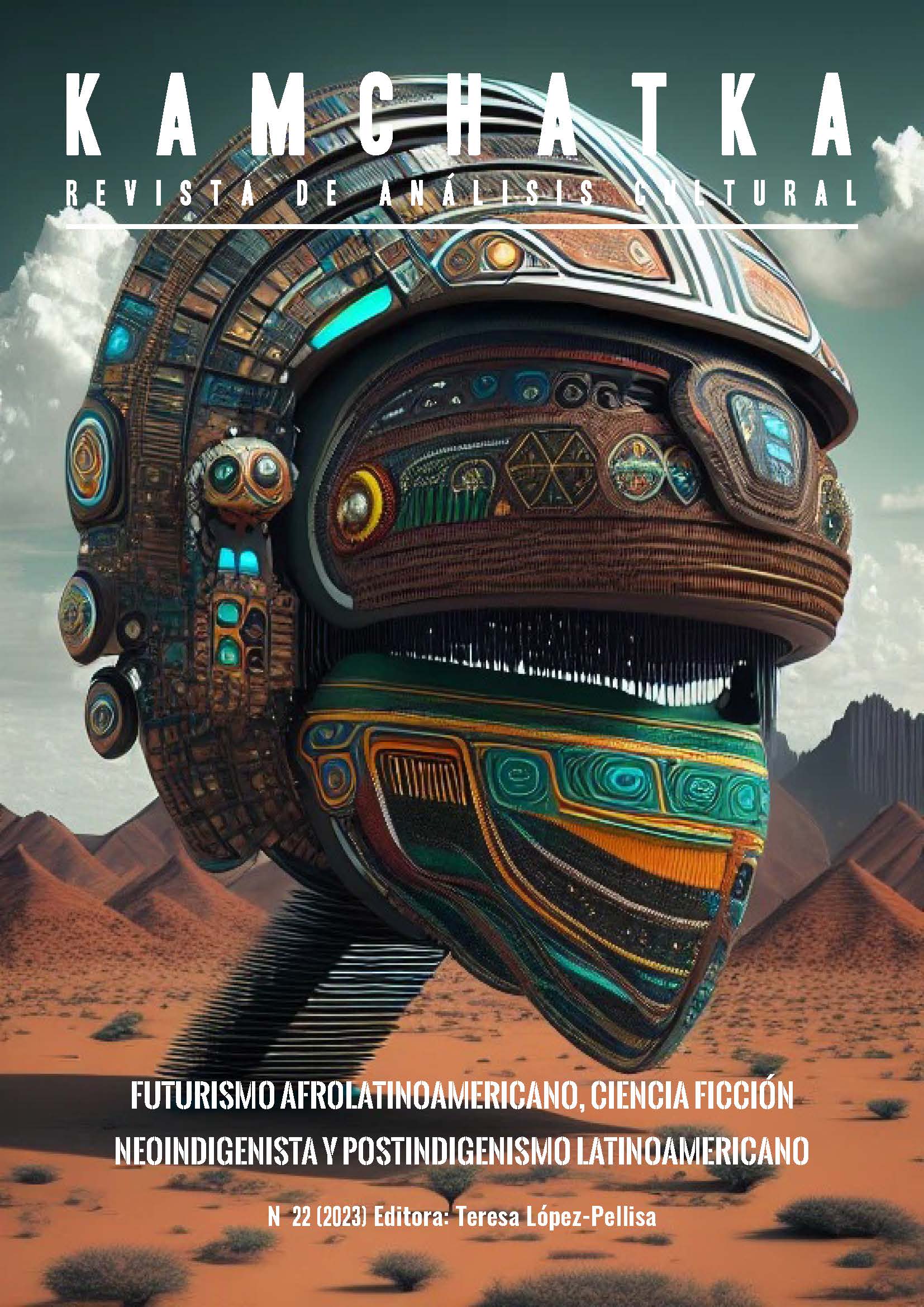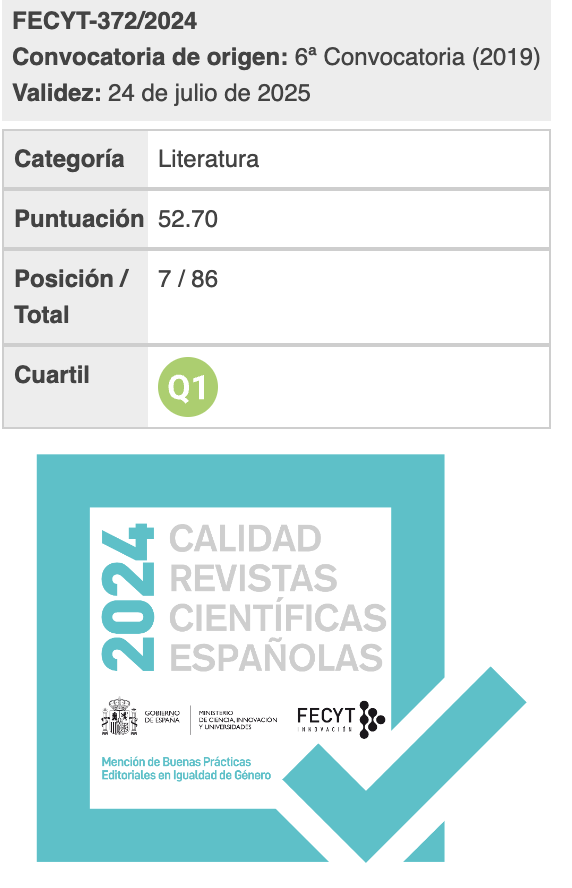Cuerpos negros y cuerpos celestes: afrofuturismo queer y nuevas espacialidades en 'Negrum3' de Diego Paulino
DOI:
https://doi.org/10.7203/KAM.22.24235Palabras clave:
Afrofuturismo brasileño, Cine negro, Utopia queer, Utopianismo transgresor Resumen
Resumen
Al lanzar su cortometraje Negrum3, el director brasileño Diego Paulino despliega un acto activista en favor de la comunidad queer de Sao Paulo. La apuesta estética del film eleva una nueva epistemología del cuerpo negro y queer haciendo uso de la analogía y apropiándose del lenguaje de la astrofísica y la ciencia ficción en respuesta al clima tenso y homofóbico generado por la derecha brasileña. Los diferentes cuerpos que reclaman el universo cinematográfico de este corto dominan los códigos de la estética afrofuturista y especulan sobre la utopia queer y el futuro de las personas negras en Brasil. Las potencialidades del futuro negro y queer son contextualizadas en relación al movimiento afrofuturista como fenómeno global en un intento de definirlo localmente en Brasil. Para lograr una aproximación a las características del afrofuturismo brasileño y su praxis se analizará el texto cultural en relación con el concepto teórico de José Muñoz de utopía queer que consiste en considerar al futuro “dentro del dominio de lo queer” y a lo queer como “un modo estructural de desear que nos permite ver y sentir más allá del presente” (2009). Además, considerando que Paulino crea un universo utópico y estético con el cuerpo negro como epicentro extremadamente crítico de la situación presente, su obra será considerada como un caso de “utopianismo transgresor”, concepto elaborado por la teórica Lucy Anderson (2000).
 Descargas
Descargas
 Citas
Citas
Andrade, Oswald de. “Manifesto Antropófago.” Do Pau-Brasil a ante das utopias. 6, (1972): 11-19.
Arenas, Fernando (2003). Utopias of otherness: nationhood and subjectivity in Portugal and Brazil. Minneapolis: University of Minnesota Press.
Brooks, Lonny Avi (2016). “Playing a Minority Forcaster in Search of Afrofuturism: Where am I in This Future, Stewart Brand?”. Anderson Reynaldo y Jones Charles E. (eds.). Afrofuturism 2.0 The Rise of Astro-Blackness. London: Lexington Books: 149-166.
Bulbul, Zózimo (1974). Alma no olho. Brazil: Zózimo Bulbul.
Colmon, Clayton D. “Queer Afrofuturism: Utopia, Sexuality, and Desire in Samuel Delany’s “Aye, and Gomorrah”.” Utopian Studies, 2 (2017): 327-346.
Coney, John (1974). Space is the Place. United States: Jim Newman.
Dery, Mark (1994). “Black to the future: interviews with Samuel R. Delany, Greg Tate, and Tricia Rose” Flame Wars: The Discourse of Cyberculture. Durham and London: Duke University Press.
Drygalska, Eva. “Space Is the Place: Black Cinema in Search of Speculative Fictions”. The Journal of Popular Culture, 4 (2019): 910-930.
Eshun, Kodwo. “Further Considerations on Afrofuturism.” CR: The New Centennial Review, 3.2 (2003): 287–302.
Freitas Kênia and José Messias. “O futuro será negro ou não será: Afrofuturismo versus Afropessimismo - as distopias do presente”. Revista de la Asociación Argentina de Estudios de Cine y Audiovisual, 17 (2018): 402-424.
Frye, David and Rama, Angel (2012). Writing across Cultures: Narrative Transculturation in Latin America. Durham: Duke University Press.
Freyre, Gilberto (1946). The Masters and the Slaves. Trans. Samuel Putnam. New York: Alfred A. Knopf.
Jones, Angela (2013). A Critical Inquiry into Queer Utopias. New York: Palgrave Macmillan.
Giorgi, Gabriel (2014). Formas comunes: Animalidad, cultura, biopolítica. Buenos Aires: Eterna Cadencia.
Halberstam, Jack (2011). The Queer Art of Failure. Durham: Duke University Press.
Kilgore, De Witt Douglas (2014). “Afrofuturism.” The Oxford Handbook of Science Fiction. Latham Rob (ed.). New York: Oxford University Press: 561-72.
Lavender III, Isiah, and Yaszek, Lisa (2020). Literary Afrofuturism in the Twenty-First Century. Chicago: Ohio State University Press.
Muñoz, José Esteban (2009) Cruising Utopia. New York: NYU Press.
Muñoz, José Esteban (1999). Disidentifications: Queers of Color and the Performance of Politics. Minneapolis: University of Minnesota Press.
Oliveira, Janaína. “With the Alma no Olho: Notes on Contemporary Black Cinema”. Film quarterly, 74-1 (2020): 32-38.
Oliveira, Valdina (2017). “Afro-Brazilian Religion, Resistance and Environmental Ethics A Perspective from Candomblé”. Harris Melanie (eds.). Ecowomanism, Religion and Ecology. Leiden: Brill.
Paulino, Diego (2018). Negrum3. Brazil: Reptilia Produçôes.
Pierce, Joseph M. “I Monster: Embodying Trans and Travesti Resistance in Latin America”. Latin American Research Review, 55 (2020): 305–321.
Preciado, Paul (2013). Testo junkie: sex, drugs, and biopolitics in the pharmacopornographic era. New York: The Feminist Press at the City University of New York.
Ríos, Felipe Luis, et al. “Axé, práticas corporais e Aids nas religiões africanistas do Recife, Brasil”. Temas Livres, 18 (2013): 3653-3651. https://doi.org/10.1590/S1413-81232013001200021
Rollefson, Griffith. “The Robot Voodoo Power Thesis: Afrofuturism and Anti-Anti-Essentialism from Sun Ra to Kool Keith”. Black Music Research Journal, 1 (2008): 83-109.
Sargisson, Lucy (2000). Utopian Bodies and the Politics of Transgression. London: Routledge.
Womack, Ytasha L (2013). Afrofuturism: The World of Black Sci-Fi and Fantasy Culture. Chicago: Lawrence Hill Books.
Yaszek, Lisa. “Race in Science Fiction: The Case of Afrofuturism and New Hollywood.” A Virtual Introduction to Science Fiction (2013).
Descargas
Publicado
Cómo citar
-
Resumen721
-
Artículo PDF 428
Número
Sección
Licencia
Los textos publicados en esta revista están –si no se indica lo contrario– bajo una licencia Reconocimiento-NoComercial 4.0 de Creative Commons. Puede copiarlos, distribuirlos y comunicarlos públicamente siempre que cite su autor y el nombre de esta publicación, Kamchatka. Revista de análisis cultural y no los utilice para fines comerciales. La licencia completa se puede consultar en Creative Commons.
Aquellos autores/as que tengan publicaciones con esta revista, aceptan los términos siguientes:
- Los autores/as conservarán sus derechos de autor y garantizarán a la revista el derecho de primera publicación de su obra, el cuál estará simultáneamente sujeto a la Licencia de reconocimiento no comercial de Creative Commons que permite a terceros compartir la obra siempre que se indique su autor y su primera publicación esta revista.
- Los autores/as podrán adoptar otros acuerdos de licencia no exclusiva de distribución de la versión de la obra publicada (p. ej.: depositarla en un archivo telemático institucional o publicarla en un volumen monográfico) siempre que se indique la publicación inicial en esta revista.
- Se permite y recomienda a los autores/as difundir su obra a través de Internet (p. ej.: en archivos telemáticos institucionales o en su página web) antes y durante el proceso de envío, lo cual puede producir intercambios interesantes y aumentar las citas de la obra publicada.





